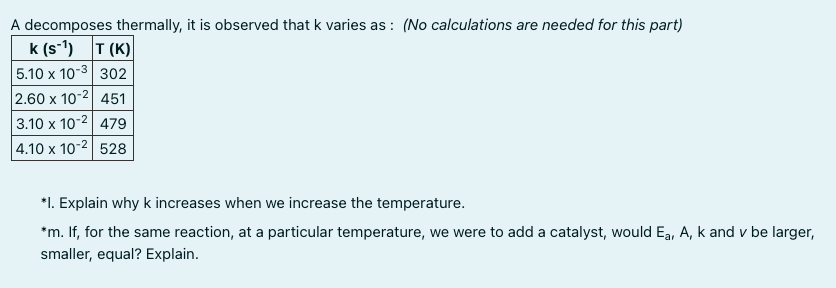Consider the reaction: 3A → 4C Initially, and at some fixed temperature, the reaction proceeds at such a rate that 200 millimoles of A are consumed in 1 minute and 47 seconds. The reaction takes place in 1.00 L. a. Express the rate of the reaction as a function of the rates of appearance and disappearance of A and C. b. Find the initial rate of the reaction. Experimental data are expressed in the table below. t (s) [A], M 0.00 4.20 10.0 3.20 20.0 2.45 30.0 1.87 40.0 1.42 50.0 1.09 *c. Determine the order of the reaction. Is the reaction elementary? e. Find the rate constant and express the rate law for this reaction. f. Find the period of time between the 7th half-life and 8th half-life. ¥h. What will be the time when 37.0% of A will have reacted (t37%)?
Consider the reaction: 3A → 4C Initially, and at some fixed temperature, the reaction proceeds at such a rate that 200 millimoles of A are consumed in 1 minute and 47 seconds. The reaction takes place in 1.00 L. a. Express the rate of the reaction as a function of the rates of appearance and disappearance of A and C. b. Find the initial rate of the reaction. Experimental data are expressed in the table below. t (s) [A], M 0.00 4.20 10.0 3.20 20.0 2.45 30.0 1.87 40.0 1.42 50.0 1.09 *c. Determine the order of the reaction. Is the reaction elementary? e. Find the rate constant and express the rate law for this reaction. f. Find the period of time between the 7th half-life and 8th half-life. ¥h. What will be the time when 37.0% of A will have reacted (t37%)?
Chemistry & Chemical Reactivity
9th Edition
ISBN:9781133949640
Author:John C. Kotz, Paul M. Treichel, John Townsend, David Treichel
Publisher:John C. Kotz, Paul M. Treichel, John Townsend, David Treichel
Chapter14: Chemical Kinetics: The Rates Of Chemical Reactions
Section: Chapter Questions
Problem 12PS: The reaction 2 NO(g) + 2 H2(g) N2(g) + 2 H2O(g) was studied at 904 C, and the data in the table...
Related questions
Question
This is all part of the same question.
![Consider the reaction: 3A → 4C
Initially, and at some fixed temperature, the reaction proceeds at such a rate that 200 millimoles of A are consumed in 1
minute and 47 seconds. The reaction takes place in 1.00 L.
a. Express the rate of the reaction as a function of the rates of appearance and disappearance of A and C.
b. Find the initial rate of the reaction.
Experimental data are expressed in the table below.
t (s) [A], M
0.00
4.20
10.0
3.20
20.0
2.45
30.0
1.87
40.0
1.42
50.0
1.09
*c. Determine the order of the reaction. Is the reaction elementary?
e. Find the rate constant and express the rate law for this reaction.
f. Find the period of time between the 7th half-life and 8th half-life.
¥h. What will be the time when 37.0% of A will have reacted (t37%)?
¥i. What will be the concentration of [C] at t37%?](/v2/_next/image?url=https%3A%2F%2Fcontent.bartleby.com%2Fqna-images%2Fquestion%2F7dafd7b2-34be-4e18-bb46-7d62daf9229a%2F6b80f7c2-bbbb-483e-8035-674a7e54ec3b%2Fpntfoy_processed.png&w=3840&q=75)
Transcribed Image Text:Consider the reaction: 3A → 4C
Initially, and at some fixed temperature, the reaction proceeds at such a rate that 200 millimoles of A are consumed in 1
minute and 47 seconds. The reaction takes place in 1.00 L.
a. Express the rate of the reaction as a function of the rates of appearance and disappearance of A and C.
b. Find the initial rate of the reaction.
Experimental data are expressed in the table below.
t (s) [A], M
0.00
4.20
10.0
3.20
20.0
2.45
30.0
1.87
40.0
1.42
50.0
1.09
*c. Determine the order of the reaction. Is the reaction elementary?
e. Find the rate constant and express the rate law for this reaction.
f. Find the period of time between the 7th half-life and 8th half-life.
¥h. What will be the time when 37.0% of A will have reacted (t37%)?
¥i. What will be the concentration of [C] at t37%?

Transcribed Image Text:A decomposes thermally, it is observed that k varies as : (No calculations are needed for this part)
k (s-1) T (K)
5.10 x 10-3 302
2.60 x 10-2 451
3.10 x 10-2| 479
4.10 x 10-2 528
*1. Explain why k increases when we increase the temperature.
*m. If, for the same reaction, at a particular temperature, we were to add a catalyst, would Ea, A, k and v be larger,
smaller, equal? Explain.
Expert Solution
This question has been solved!
Explore an expertly crafted, step-by-step solution for a thorough understanding of key concepts.
Step by step
Solved in 4 steps with 2 images

Knowledge Booster
Learn more about
Need a deep-dive on the concept behind this application? Look no further. Learn more about this topic, chemistry and related others by exploring similar questions and additional content below.Recommended textbooks for you

Chemistry & Chemical Reactivity
Chemistry
ISBN:
9781133949640
Author:
John C. Kotz, Paul M. Treichel, John Townsend, David Treichel
Publisher:
Cengage Learning

Chemistry & Chemical Reactivity
Chemistry
ISBN:
9781337399074
Author:
John C. Kotz, Paul M. Treichel, John Townsend, David Treichel
Publisher:
Cengage Learning

Chemistry for Engineering Students
Chemistry
ISBN:
9781337398909
Author:
Lawrence S. Brown, Tom Holme
Publisher:
Cengage Learning

Chemistry & Chemical Reactivity
Chemistry
ISBN:
9781133949640
Author:
John C. Kotz, Paul M. Treichel, John Townsend, David Treichel
Publisher:
Cengage Learning

Chemistry & Chemical Reactivity
Chemistry
ISBN:
9781337399074
Author:
John C. Kotz, Paul M. Treichel, John Townsend, David Treichel
Publisher:
Cengage Learning

Chemistry for Engineering Students
Chemistry
ISBN:
9781337398909
Author:
Lawrence S. Brown, Tom Holme
Publisher:
Cengage Learning

Chemistry by OpenStax (2015-05-04)
Chemistry
ISBN:
9781938168390
Author:
Klaus Theopold, Richard H Langley, Paul Flowers, William R. Robinson, Mark Blaser
Publisher:
OpenStax

Chemistry for Engineering Students
Chemistry
ISBN:
9781285199023
Author:
Lawrence S. Brown, Tom Holme
Publisher:
Cengage Learning

Chemistry
Chemistry
ISBN:
9781305957404
Author:
Steven S. Zumdahl, Susan A. Zumdahl, Donald J. DeCoste
Publisher:
Cengage Learning